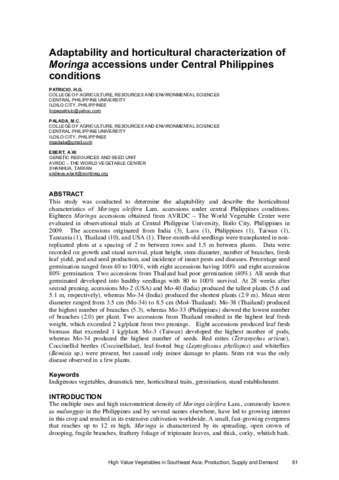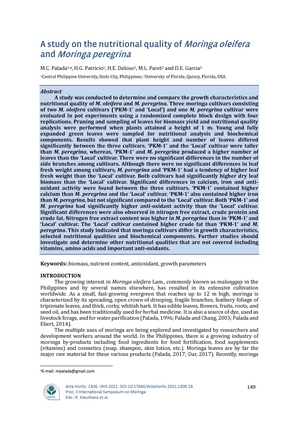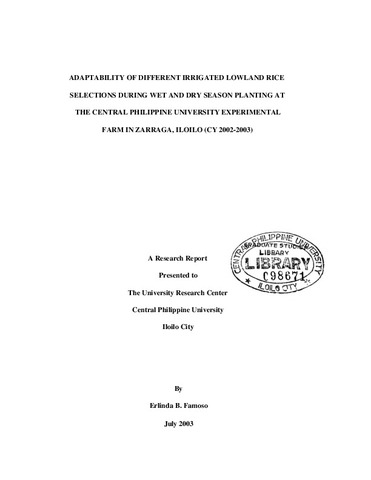Adaptability and horticultural characterization of different moringa accessions in Central Philippines
| dc.contributor.author | Patricio, Hope G. | |
| dc.contributor.author | Palada, Manuel C. | |
| dc.date.accessioned | 2022-07-05T00:54:22Z | |
| dc.date.available | 2022-07-05T00:54:22Z | |
| dc.date.issued | 2017-05-29 | |
| dc.identifier.citation | Patricio, H. G. and Palada, M. C. (2017). Adaptability and horticultural characterization of different moringa accessions in Central Philippines. In Ebert, A. W. and Palada, M.C. (Eds.), I International Symposium on Moringa (pp. 45-53). International Society for Horticultural Science. https://doi.org/10.17660/ActaHortic.2017.1158.6 | en_US |
| dc.identifier.isbn | 978-94-62611-55-9 | |
| dc.identifier.issn | 0567-7572 | |
| dc.identifier.uri | https://hdl.handle.net/20.500.12852/2129 | |
| dc.description | Conference paper | en_US |
| dc.description.abstract | Eighteen moringa accessions from AVRDC - The World Vegetable Center were evaluated for their adaptability and horticultural characteristics in an observational trial at Central Philippine University, Iloilo City, Philippines from June 2009 to May 2012. The accessions originated from India, Laos, Philippines, Taiwan, Tanzania, Thailand and USA. Eight accessions had 100% germination, another eight had 80% while two accessions from Thailand had only 40% germination. All seeds that germinated developed into healthy seedlings with 75 to 100% survival. At 28 weeks after second pruning, accessions Mo-2 (USA) and Mo-40 (India) were the tallest whereas Mo-34 (India) was the shortest. Mean stem diameter ranged from 3.5 (Mo-34) to 8.5 cm (Mo-4, Thailand). Mo-38 (Thailand) had the most branches, whereas Mo-33 (Philippines) had the least. Two accessions from Thailand (Mo-4 and Mo-14) had the highest leaf fresh weight. However, Mo-6 (Thailand) produced the highest percent dry matter. Of the 18 accessions, only 11 developed flowers which started to appear 49 to 93 days after transplanting (DAT). Of these 11 accessions, only 9 produced pods which developed from 75 to 182 DAT. Mo-3 (Taiwan) developed the most pods but Mo-34 produced the most seeds one year after planting. Three years after planting, all the accessions except Mo-4 and Mo-6 developed flowers, pods and seeds with Mo-38 producing the most seeds per pod and Mo-15 having the most seeds per tree. Red mites (Tetranychus urticae), defoliators, leaf-footed bug (Leptoglossus phyllopus) and whiteflies (Bemisia sp.) were present in the field but caused only minor damage to plants. Stem rot was the only pathogenic disease observed. These results indicate that Mo-4 and Mo-14 are ideal for fresh leaves whereas Mo-2 and Mo-6 are ideal for dry matter production. Furthermore, Mo-15, Mo-7, Mo-9 and Mo-34 are desirable accessions for seed production. | en_US |
| dc.description.sponsorship | University Research Center | en_US |
| dc.language.iso | en | en_US |
| dc.publisher | International Society for Horticultural Science | en_US |
| dc.relation.ispartofseries | ISHS Acta Horticulturae;1158 | |
| dc.subject.lcsh | Moringa oleifera | en_US |
| dc.subject.lcsh | Moringa | en_US |
| dc.subject.lcsh | Horticulture | en_US |
| dc.subject.lcsh | Plants--Adaptation | en_US |
| dc.subject.lcsh | Moringa--Adaptation | en_US |
| dc.subject.lcsh | Moringa oleifera--Adaptation | en_US |
| dc.subject.lcsh | Adaptation (Biology) | en_US |
| dc.subject.lcsh | Agricultural pests | en_US |
| dc.subject.lcsh | Plant diseases | en_US |
| dc.subject.lcsh | Philippines | en_US |
| dc.title | Adaptability and horticultural characterization of different moringa accessions in Central Philippines | en_US |
| dc.type | Conference paper | en_US |
| dcterms.accessRights | Limited public access | en_US |
| dc.citation.firstpage | 45 | en_US |
| dc.citation.lastpage | 53 | en_US |
| local.subject | Indigenous vegetables | en_US |
| local.subject | Drumstick tree | en_US |
| local.subject | Horticultural traits | en_US |
| local.subject | Germination | en_US |
| local.subject | Stand establishment | en_US |
| local.subject.scientificname | Moringa | en_US |
| local.subject.scientificname | Moringa oleifera | en_US |
| dc.identifier.doi | 10.17660/ActaHortic.2017.1158.6 | |
| dc.citation.conferencetitle | I International Symposium on Moringa | en_US |
| dc.identifier.essn | 2406-6168 |
Files in this item
| Files | Size | Format | View |
|---|---|---|---|
|
There are no files associated with this item. |
|||




